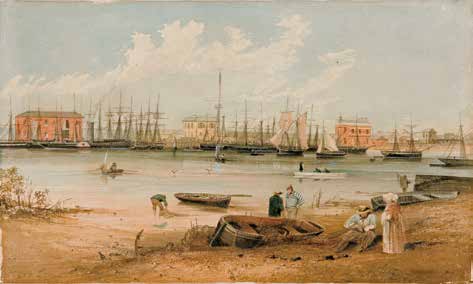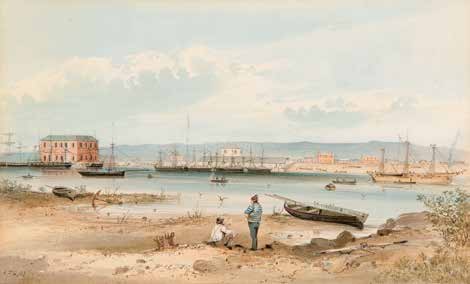PORT ADELAIDE, 1848
S.T. GILL
watercolour on paper
28.0 x 49.0 cm
signed with initials and dated lower left: S.T.G. / 1848
Frank T. Sabin, London
Kendall Whaling Museum, Sharon, Massachusetts, USA, 1967
New Bedford Whaling Museum, Massachusetts, USA, 2001 (museums merged)
New Bedford Whaling Museum deaccession
Marion Antiques & Turkey Auctions, Massachusetts, USA, 9 April 2022, lot 9 (as ‘South Australia, Port Adelaide’)
Private collection, Melbourne
Port Adelaide looking across Gawler Reach, 1847, watercolour on paper, 19.7 x 32.4 cm, in the collection of Art Gallery of South Australia, Adelaide
Port Adelaide looking across Gawler Reach, 1848, watercolour on paper, 28.2 x 46.1 cm, in the collection of Art Gallery of South Australia, Adelaide
1 fill.jpg

Widely recognised as one of the most engaging and observant artists of Australian colonial life, the young Samuel Thomas Gill, aged twenty-one, arrived with his parents and siblings in December 1839, only three years after Adelaide was founded on the lands of the Kaurna people. Having received training in Plymouth and London, within three months Gill was promoting his artistic availability. In an advertisement in The South Australian Gazette and Colonial Register, he proclaimed his willingness to capture ‘correct likenesses’ of individuals, horses, dogs, local scenery and residences ‘sketched and… suited for home conveyance’, to record and inform distant family and friends of life in Australia.1 In addition to these domestic genres, Gill travelled to townships around the colony, undertaking commissions including recording the early copper and silver mining industries, and participating in exploratory travels.
Gill’s skill and presence in the new city was a boon to those wishing to have evidence of its growth, and to promote its possibilities. In 1845, he was commissioned by local newspaper owner James Allen to paint a series of views of Adelaide, which Allen then took to England and used to illustrate a series of lectures in 1846, intended to entice immigrants and investment. This program was heartily supported by the South Australia Company, the original investors in this colony-as-commercial-enterprise, who subsequently owned many of the paintings. The majority of the views displayed by Allen were lively streetscapes of Adelaide’s major roads, marvellous records of the town’s early architecture and bustling population. The commission also included two views of Port Adelaide. Built on the mangrove-lined tidal estuary of Yerta Bulti, as it is known to its original owners, and following considerable debate about its best (or least worst) location, the Port had been formally opened in its current location in 1840.
Gill is well known for returning in his later years to earlier scenes and events, as with his series recalling life on the goldfields commissioned by the Melbourne Public Library (now State Library Victoria) in 1869, or episodes from the ill-fated Horrocks Expedition of 1846. Port Adelaide, however, was one location that he captured in multiple watercolours in a short period of time, evidence of this vital infrastructure for exporting the proceeds of its new produce, agricultural and mineral industries. With the emergence of this wonderful watercolour from institutional storage, four finished watercolours of this outlook on the banks of Gawler’s Reach are now known (two in the Art Gallery of South Australia; National Library of Australia), plus further studies.2 Another earlier version (presumably one of Allen’s) remains unlocated, the source of the watercolour painted in London by English artist-copyist Thomas Hosmer Shepherd (now Art Gallery of South Australia), and also for the hand-coloured lithograph in George French Angas’ South Australia Illustrated, published in London in 1847. Views by Gill from the other side of the river are also known in multiples.3
1 gill 2.jpg

The scene here looks southeast across the calm river to the port’s facilities and the Mount Lofty Ranges on the distant horizon. On the left, the large red two-storeyed building is the warehouse of the South Australian Company, above their McLaren Wharf (named for the manager of the Company). The central light-coloured stone building is the Customs House, above the Government’s Queen’s Wharf and warehouses. And the third building of note, on the right, is the Port Tavern, now proudly two-storey like the others. This was a comparatively recent development after the original single-storey building was destroyed by fire on 29 January 1847. In Gill’s various versions, we can see the original tavern, construction in progress amid a grid of scaffolding, and the resulting new tavern. Thus by 1848, when this painting was created, the Company, Government and inn make up the triumvirate of buildings necessary for seamen in town and mercantile activity.
Before them, upon the river, Gill depicts a range of watercraft, from ships that have sailed across turbulent oceans to small dinghies and rowboats. It is clear that Gill made close observations of these vessels. Versions painted up to 1847 show the French ship Ville de Bordeaux, which had been seized for illegal trading, at anchor at the right of the image. In the Art Gallery of South Australia’s 1848 watercolour, the steamer Juno is depicted on the left, one of the first examples of steam-powered ships to travel to the colony. Interestingly, the South Australia Company also owned that watercolour, demonstrating their understandable ongoing interest in the development of the Port and their resulting profits. The Company subsequently donated that and other paintings to the now Art Gallery of South Australia in 1890.4
While Gill carefully recorded the ships, it is impossible to say how much the characters who populate the foreground of these works are individuals he observed, or whether they are ‘types’ – staffage drawn from his precise grasp of anatomy and posture. There is evident repetition in the foreground accoutrements – the rotting wicker basket, discarded wine bottles, spar and anchor, and remnant mangroves on the muddy bank – but there is little sense of rote duplication in these paintings. Instead, Gill makes evident his enjoyment in each scene, deftly capturing the trivia of daily life, from mending a net to contemplating the changing tide.
For the last fifty-five years, this watercolour has been in the United States, in the Kendall Whaling Museum collection, later merged with the New Bedford Whaling Museum. Commercial whaling had begun in South Australian waters long before the colony was founded, and whaling was the first industry established by the South Australia Company upon its arrival on Kaurna land in 1836. Although American whalers were active in these waters from the early 1800s, it is understandable that the Museum decided this painting was not relevant to their collection. Their custodianship has, however, helped protect it from excessive light exposure and the watercolour retains its crisp colours for our enjoyment today.
1. South Australian Gazette and Colonial Register, 7 March 1840, p. 1
2. A small watercolour is either by Gill or his friend Eliezer Montefiore (State Library of New South Wales SSV*/Sp Coll/Gill/3), while the National Library of Australis holds related sketches.
3. See David Coombe’s interactive map of Gill’s depictions of Port Adelaide at umap.openstreetmap.fr/en/map/s-t-gill-port-adelaide_494979#17/-34.84020/138.50458
4. The South Australia Company donated art to the Art Gallery of South Australia in 1890, 1929 and 1931, twenty-four works in total – of which fifteen are by Gill.
ALISA BUNBURY
